Performance Analysis of Bega Cheese Limited
VerifiedAdded on 2021/06/14
|16
|3442
|53
AI Summary
FINANCIAL INFORMATION FOR DECISION MAKING 7 FINANCIAL INFORMATION FOR DECISION MAKING Financial information for decision making Name of the student Name of the university Student ID Author note Executive summary The main objective of the report is to analyse the performance of Bega Cheese Limited through various measures like profitability ratios, efficiency ratios, liquidity ratios and gearing ratio. It has been identified from the report that though the profitability ratio of the company significantly deteriorated over the years from 2014 to 2015, the company was able to improve the ratio during the
Contribute Materials
Your contribution can guide someone’s learning journey. Share your
documents today.
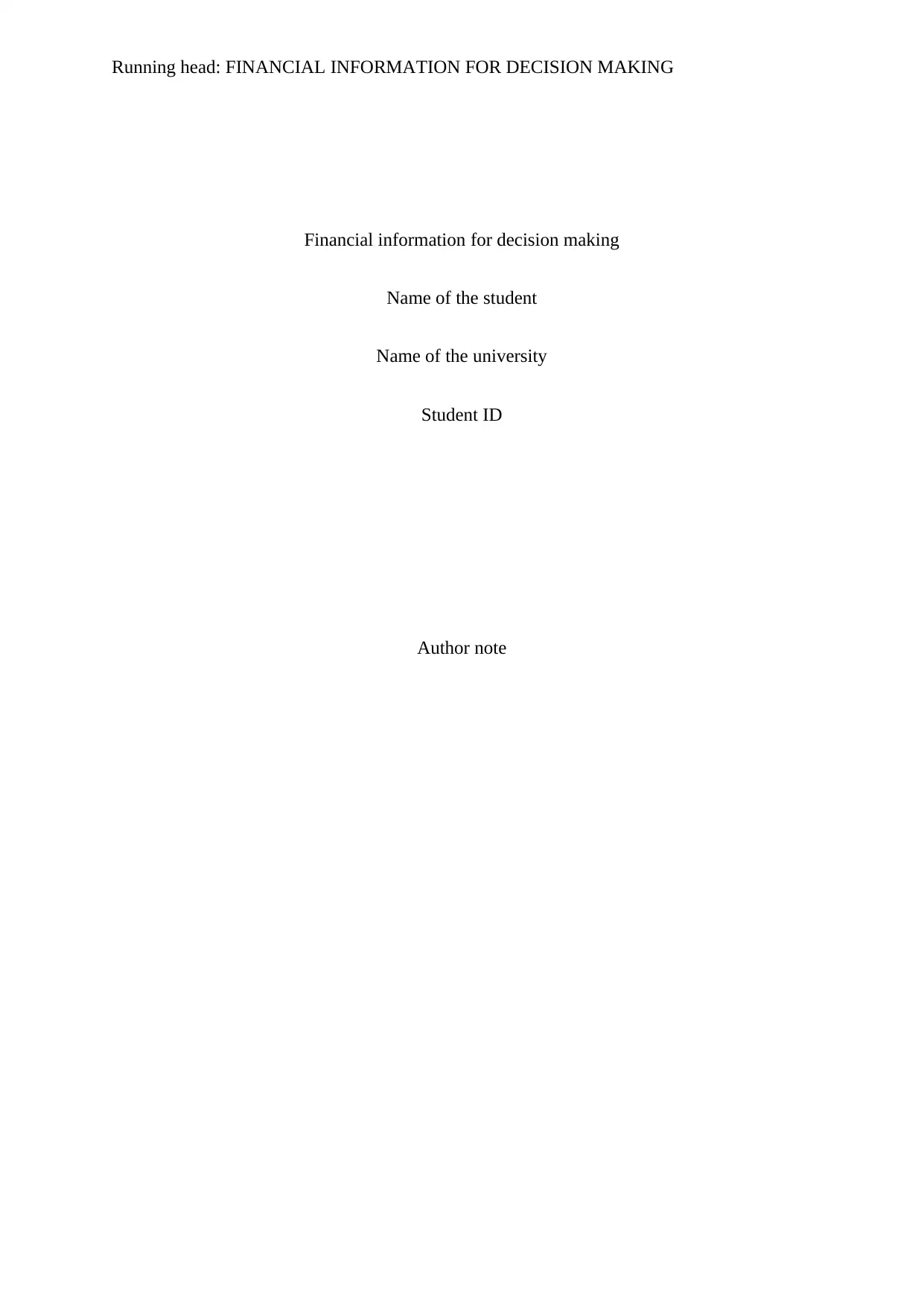
Running head: FINANCIAL INFORMATION FOR DECISION MAKING
Financial information for decision making
Name of the student
Name of the university
Student ID
Author note
Financial information for decision making
Name of the student
Name of the university
Student ID
Author note
Secure Best Marks with AI Grader
Need help grading? Try our AI Grader for instant feedback on your assignments.
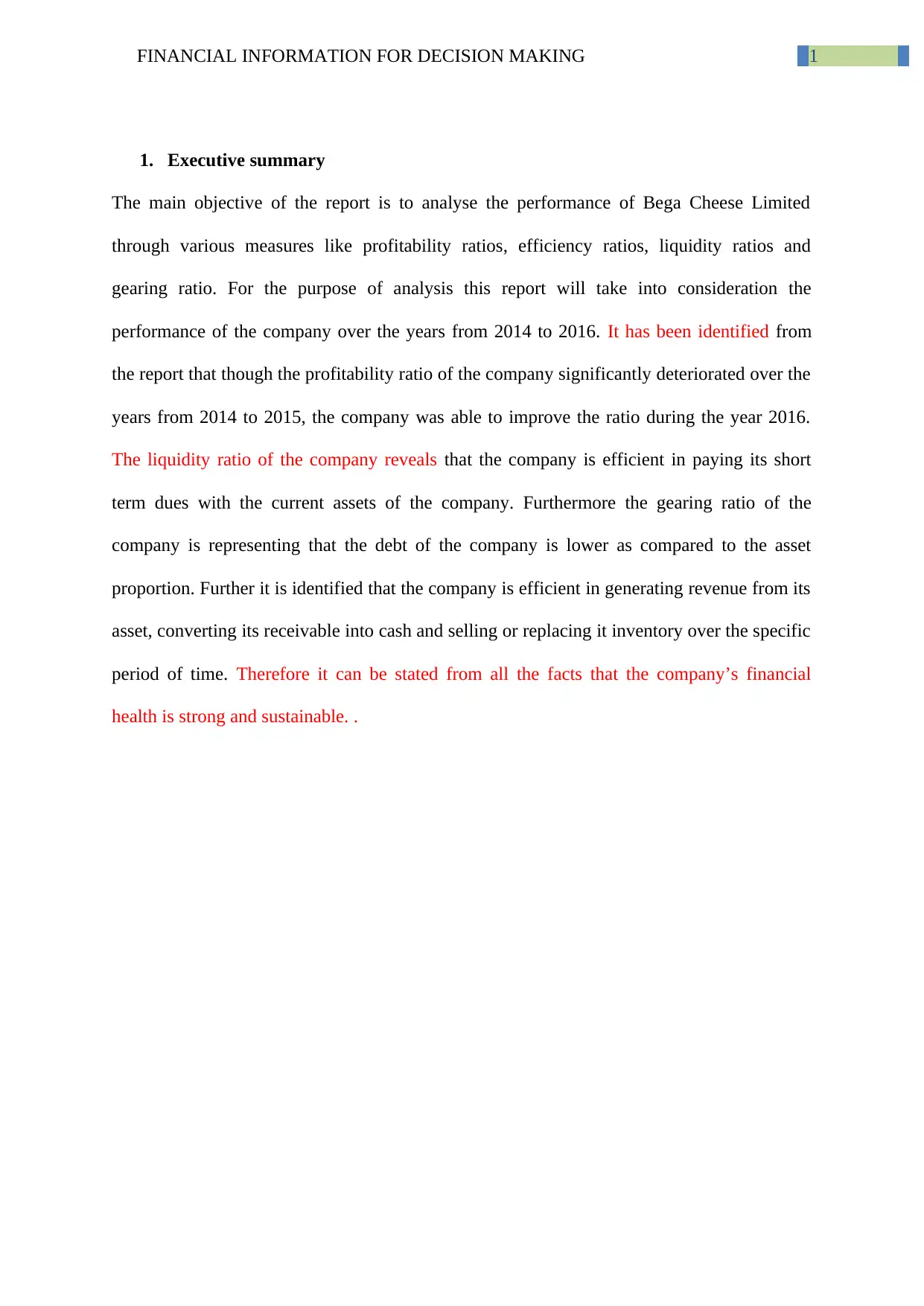
1FINANCIAL INFORMATION FOR DECISION MAKING
1. Executive summary
The main objective of the report is to analyse the performance of Bega Cheese Limited
through various measures like profitability ratios, efficiency ratios, liquidity ratios and
gearing ratio. For the purpose of analysis this report will take into consideration the
performance of the company over the years from 2014 to 2016. It has been identified from
the report that though the profitability ratio of the company significantly deteriorated over the
years from 2014 to 2015, the company was able to improve the ratio during the year 2016.
The liquidity ratio of the company reveals that the company is efficient in paying its short
term dues with the current assets of the company. Furthermore the gearing ratio of the
company is representing that the debt of the company is lower as compared to the asset
proportion. Further it is identified that the company is efficient in generating revenue from its
asset, converting its receivable into cash and selling or replacing it inventory over the specific
period of time. Therefore it can be stated from all the facts that the company’s financial
health is strong and sustainable. .
1. Executive summary
The main objective of the report is to analyse the performance of Bega Cheese Limited
through various measures like profitability ratios, efficiency ratios, liquidity ratios and
gearing ratio. For the purpose of analysis this report will take into consideration the
performance of the company over the years from 2014 to 2016. It has been identified from
the report that though the profitability ratio of the company significantly deteriorated over the
years from 2014 to 2015, the company was able to improve the ratio during the year 2016.
The liquidity ratio of the company reveals that the company is efficient in paying its short
term dues with the current assets of the company. Furthermore the gearing ratio of the
company is representing that the debt of the company is lower as compared to the asset
proportion. Further it is identified that the company is efficient in generating revenue from its
asset, converting its receivable into cash and selling or replacing it inventory over the specific
period of time. Therefore it can be stated from all the facts that the company’s financial
health is strong and sustainable. .
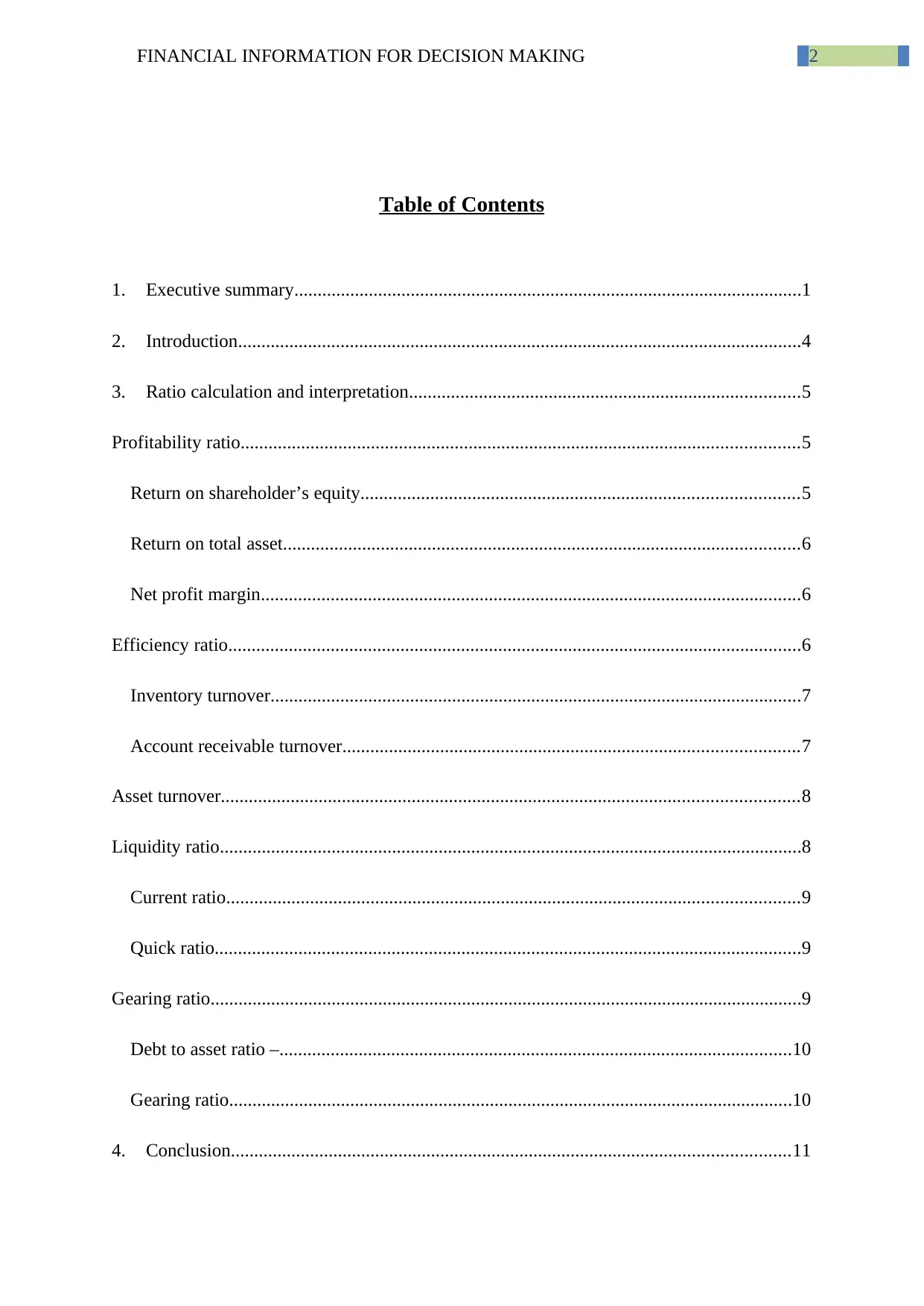
2FINANCIAL INFORMATION FOR DECISION MAKING
Table of Contents
1. Executive summary.............................................................................................................1
2. Introduction.........................................................................................................................4
3. Ratio calculation and interpretation....................................................................................5
Profitability ratio........................................................................................................................5
Return on shareholder’s equity..............................................................................................5
Return on total asset...............................................................................................................6
Net profit margin....................................................................................................................6
Efficiency ratio...........................................................................................................................6
Inventory turnover..................................................................................................................7
Account receivable turnover..................................................................................................7
Asset turnover............................................................................................................................8
Liquidity ratio.............................................................................................................................8
Current ratio...........................................................................................................................9
Quick ratio..............................................................................................................................9
Gearing ratio...............................................................................................................................9
Debt to asset ratio –..............................................................................................................10
Gearing ratio.........................................................................................................................10
4. Conclusion........................................................................................................................11
Table of Contents
1. Executive summary.............................................................................................................1
2. Introduction.........................................................................................................................4
3. Ratio calculation and interpretation....................................................................................5
Profitability ratio........................................................................................................................5
Return on shareholder’s equity..............................................................................................5
Return on total asset...............................................................................................................6
Net profit margin....................................................................................................................6
Efficiency ratio...........................................................................................................................6
Inventory turnover..................................................................................................................7
Account receivable turnover..................................................................................................7
Asset turnover............................................................................................................................8
Liquidity ratio.............................................................................................................................8
Current ratio...........................................................................................................................9
Quick ratio..............................................................................................................................9
Gearing ratio...............................................................................................................................9
Debt to asset ratio –..............................................................................................................10
Gearing ratio.........................................................................................................................10
4. Conclusion........................................................................................................................11

3FINANCIAL INFORMATION FOR DECISION MAKING
References................................................................................................................................12
Appendix..................................................................................................................................14
References................................................................................................................................12
Appendix..................................................................................................................................14
Secure Best Marks with AI Grader
Need help grading? Try our AI Grader for instant feedback on your assignments.
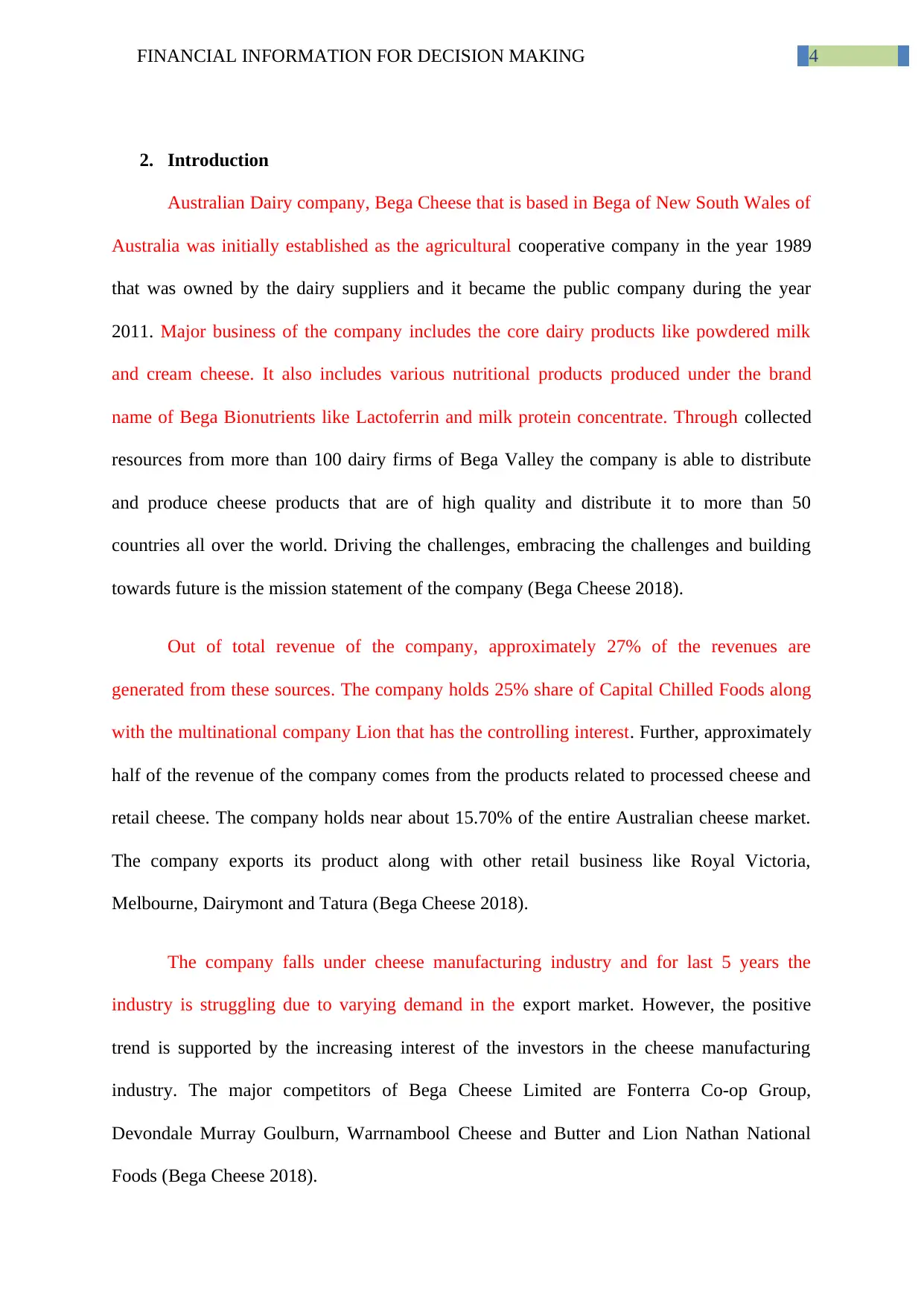
4FINANCIAL INFORMATION FOR DECISION MAKING
2. Introduction
Australian Dairy company, Bega Cheese that is based in Bega of New South Wales of
Australia was initially established as the agricultural cooperative company in the year 1989
that was owned by the dairy suppliers and it became the public company during the year
2011. Major business of the company includes the core dairy products like powdered milk
and cream cheese. It also includes various nutritional products produced under the brand
name of Bega Bionutrients like Lactoferrin and milk protein concentrate. Through collected
resources from more than 100 dairy firms of Bega Valley the company is able to distribute
and produce cheese products that are of high quality and distribute it to more than 50
countries all over the world. Driving the challenges, embracing the challenges and building
towards future is the mission statement of the company (Bega Cheese 2018).
Out of total revenue of the company, approximately 27% of the revenues are
generated from these sources. The company holds 25% share of Capital Chilled Foods along
with the multinational company Lion that has the controlling interest. Further, approximately
half of the revenue of the company comes from the products related to processed cheese and
retail cheese. The company holds near about 15.70% of the entire Australian cheese market.
The company exports its product along with other retail business like Royal Victoria,
Melbourne, Dairymont and Tatura (Bega Cheese 2018).
The company falls under cheese manufacturing industry and for last 5 years the
industry is struggling due to varying demand in the export market. However, the positive
trend is supported by the increasing interest of the investors in the cheese manufacturing
industry. The major competitors of Bega Cheese Limited are Fonterra Co-op Group,
Devondale Murray Goulburn, Warrnambool Cheese and Butter and Lion Nathan National
Foods (Bega Cheese 2018).
2. Introduction
Australian Dairy company, Bega Cheese that is based in Bega of New South Wales of
Australia was initially established as the agricultural cooperative company in the year 1989
that was owned by the dairy suppliers and it became the public company during the year
2011. Major business of the company includes the core dairy products like powdered milk
and cream cheese. It also includes various nutritional products produced under the brand
name of Bega Bionutrients like Lactoferrin and milk protein concentrate. Through collected
resources from more than 100 dairy firms of Bega Valley the company is able to distribute
and produce cheese products that are of high quality and distribute it to more than 50
countries all over the world. Driving the challenges, embracing the challenges and building
towards future is the mission statement of the company (Bega Cheese 2018).
Out of total revenue of the company, approximately 27% of the revenues are
generated from these sources. The company holds 25% share of Capital Chilled Foods along
with the multinational company Lion that has the controlling interest. Further, approximately
half of the revenue of the company comes from the products related to processed cheese and
retail cheese. The company holds near about 15.70% of the entire Australian cheese market.
The company exports its product along with other retail business like Royal Victoria,
Melbourne, Dairymont and Tatura (Bega Cheese 2018).
The company falls under cheese manufacturing industry and for last 5 years the
industry is struggling due to varying demand in the export market. However, the positive
trend is supported by the increasing interest of the investors in the cheese manufacturing
industry. The major competitors of Bega Cheese Limited are Fonterra Co-op Group,
Devondale Murray Goulburn, Warrnambool Cheese and Butter and Lion Nathan National
Foods (Bega Cheese 2018).
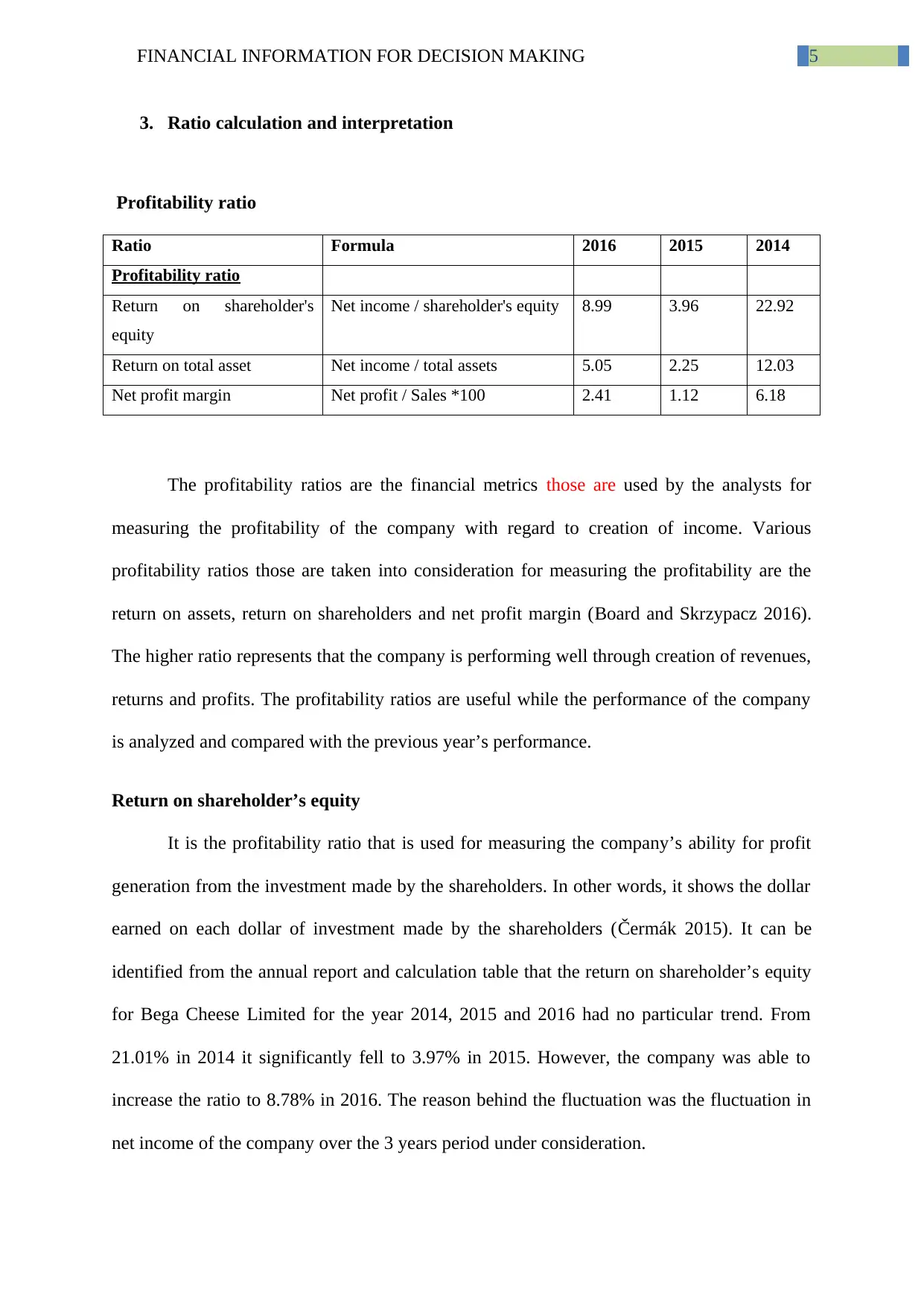
5FINANCIAL INFORMATION FOR DECISION MAKING
3. Ratio calculation and interpretation
Profitability ratio
Ratio Formula 2016 2015 2014
Profitability ratio
Return on shareholder's
equity
Net income / shareholder's equity 8.99 3.96 22.92
Return on total asset Net income / total assets 5.05 2.25 12.03
Net profit margin Net profit / Sales *100 2.41 1.12 6.18
The profitability ratios are the financial metrics those are used by the analysts for
measuring the profitability of the company with regard to creation of income. Various
profitability ratios those are taken into consideration for measuring the profitability are the
return on assets, return on shareholders and net profit margin (Board and Skrzypacz 2016).
The higher ratio represents that the company is performing well through creation of revenues,
returns and profits. The profitability ratios are useful while the performance of the company
is analyzed and compared with the previous year’s performance.
Return on shareholder’s equity
It is the profitability ratio that is used for measuring the company’s ability for profit
generation from the investment made by the shareholders. In other words, it shows the dollar
earned on each dollar of investment made by the shareholders (Čermák 2015). It can be
identified from the annual report and calculation table that the return on shareholder’s equity
for Bega Cheese Limited for the year 2014, 2015 and 2016 had no particular trend. From
21.01% in 2014 it significantly fell to 3.97% in 2015. However, the company was able to
increase the ratio to 8.78% in 2016. The reason behind the fluctuation was the fluctuation in
net income of the company over the 3 years period under consideration.
3. Ratio calculation and interpretation
Profitability ratio
Ratio Formula 2016 2015 2014
Profitability ratio
Return on shareholder's
equity
Net income / shareholder's equity 8.99 3.96 22.92
Return on total asset Net income / total assets 5.05 2.25 12.03
Net profit margin Net profit / Sales *100 2.41 1.12 6.18
The profitability ratios are the financial metrics those are used by the analysts for
measuring the profitability of the company with regard to creation of income. Various
profitability ratios those are taken into consideration for measuring the profitability are the
return on assets, return on shareholders and net profit margin (Board and Skrzypacz 2016).
The higher ratio represents that the company is performing well through creation of revenues,
returns and profits. The profitability ratios are useful while the performance of the company
is analyzed and compared with the previous year’s performance.
Return on shareholder’s equity
It is the profitability ratio that is used for measuring the company’s ability for profit
generation from the investment made by the shareholders. In other words, it shows the dollar
earned on each dollar of investment made by the shareholders (Čermák 2015). It can be
identified from the annual report and calculation table that the return on shareholder’s equity
for Bega Cheese Limited for the year 2014, 2015 and 2016 had no particular trend. From
21.01% in 2014 it significantly fell to 3.97% in 2015. However, the company was able to
increase the ratio to 8.78% in 2016. The reason behind the fluctuation was the fluctuation in
net income of the company over the 3 years period under consideration.
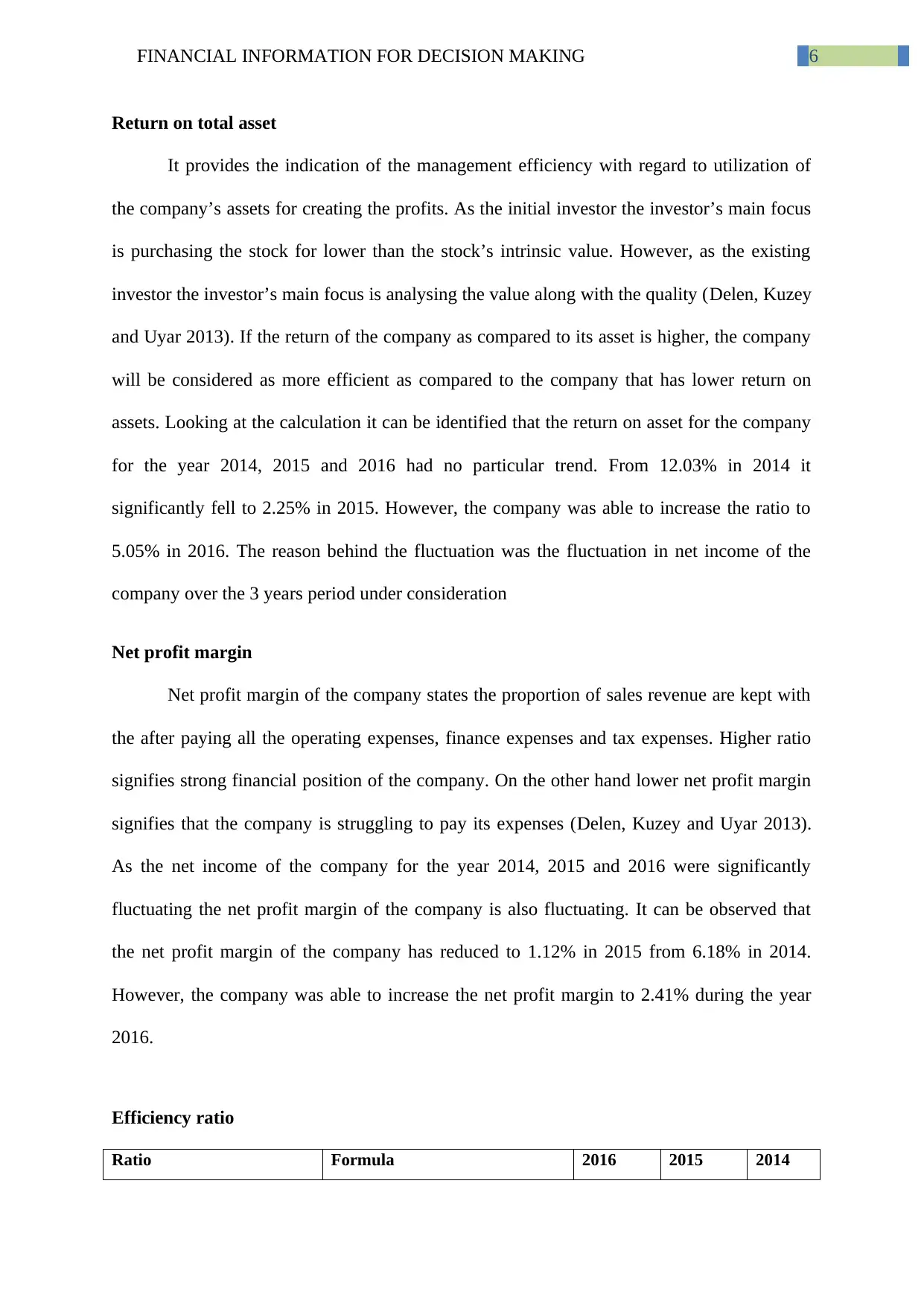
6FINANCIAL INFORMATION FOR DECISION MAKING
Return on total asset
It provides the indication of the management efficiency with regard to utilization of
the company’s assets for creating the profits. As the initial investor the investor’s main focus
is purchasing the stock for lower than the stock’s intrinsic value. However, as the existing
investor the investor’s main focus is analysing the value along with the quality (Delen, Kuzey
and Uyar 2013). If the return of the company as compared to its asset is higher, the company
will be considered as more efficient as compared to the company that has lower return on
assets. Looking at the calculation it can be identified that the return on asset for the company
for the year 2014, 2015 and 2016 had no particular trend. From 12.03% in 2014 it
significantly fell to 2.25% in 2015. However, the company was able to increase the ratio to
5.05% in 2016. The reason behind the fluctuation was the fluctuation in net income of the
company over the 3 years period under consideration
Net profit margin
Net profit margin of the company states the proportion of sales revenue are kept with
the after paying all the operating expenses, finance expenses and tax expenses. Higher ratio
signifies strong financial position of the company. On the other hand lower net profit margin
signifies that the company is struggling to pay its expenses (Delen, Kuzey and Uyar 2013).
As the net income of the company for the year 2014, 2015 and 2016 were significantly
fluctuating the net profit margin of the company is also fluctuating. It can be observed that
the net profit margin of the company has reduced to 1.12% in 2015 from 6.18% in 2014.
However, the company was able to increase the net profit margin to 2.41% during the year
2016.
Efficiency ratio
Ratio Formula 2016 2015 2014
Return on total asset
It provides the indication of the management efficiency with regard to utilization of
the company’s assets for creating the profits. As the initial investor the investor’s main focus
is purchasing the stock for lower than the stock’s intrinsic value. However, as the existing
investor the investor’s main focus is analysing the value along with the quality (Delen, Kuzey
and Uyar 2013). If the return of the company as compared to its asset is higher, the company
will be considered as more efficient as compared to the company that has lower return on
assets. Looking at the calculation it can be identified that the return on asset for the company
for the year 2014, 2015 and 2016 had no particular trend. From 12.03% in 2014 it
significantly fell to 2.25% in 2015. However, the company was able to increase the ratio to
5.05% in 2016. The reason behind the fluctuation was the fluctuation in net income of the
company over the 3 years period under consideration
Net profit margin
Net profit margin of the company states the proportion of sales revenue are kept with
the after paying all the operating expenses, finance expenses and tax expenses. Higher ratio
signifies strong financial position of the company. On the other hand lower net profit margin
signifies that the company is struggling to pay its expenses (Delen, Kuzey and Uyar 2013).
As the net income of the company for the year 2014, 2015 and 2016 were significantly
fluctuating the net profit margin of the company is also fluctuating. It can be observed that
the net profit margin of the company has reduced to 1.12% in 2015 from 6.18% in 2014.
However, the company was able to increase the net profit margin to 2.41% during the year
2016.
Efficiency ratio
Ratio Formula 2016 2015 2014
Paraphrase This Document
Need a fresh take? Get an instant paraphrase of this document with our AI Paraphraser
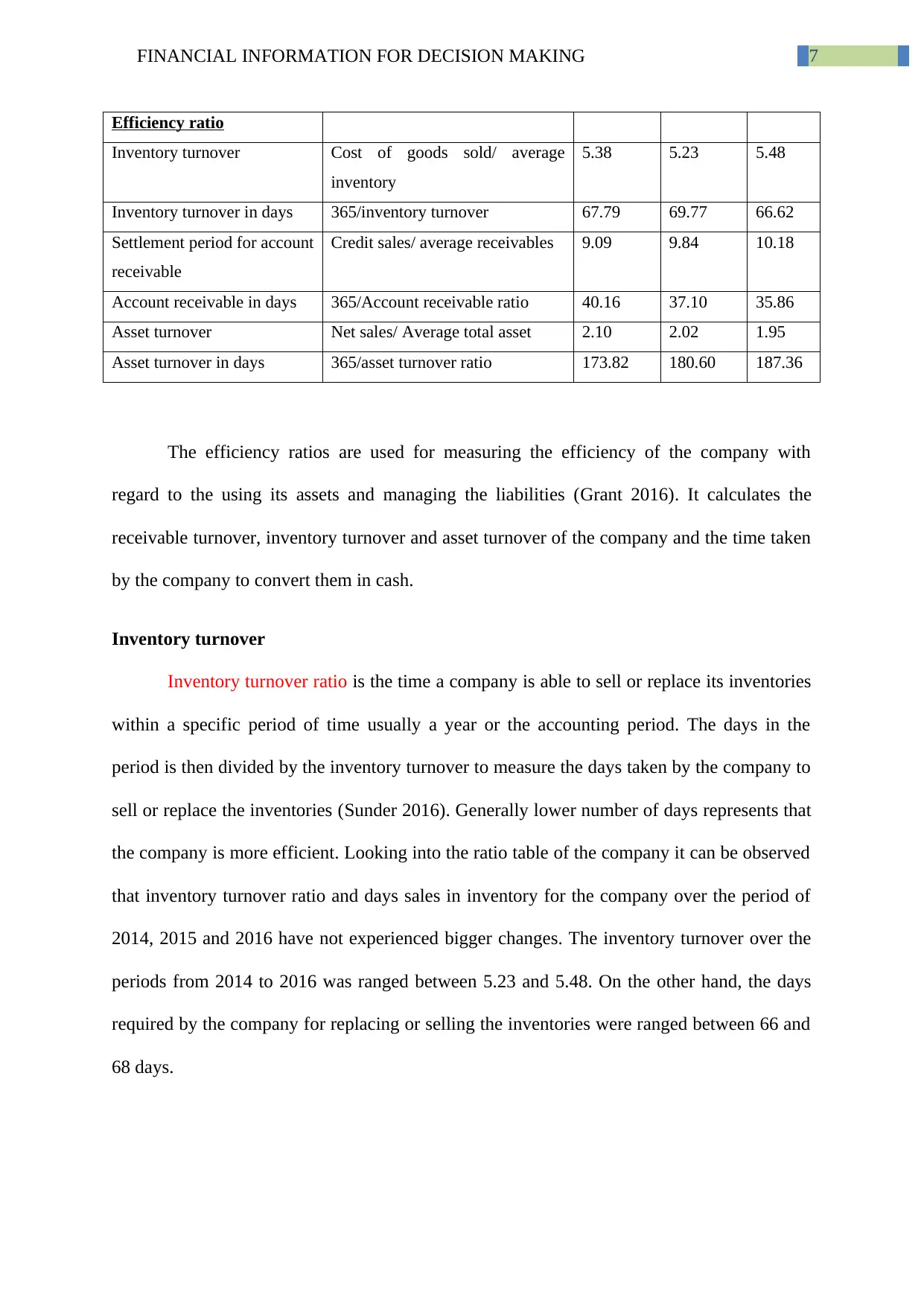
7FINANCIAL INFORMATION FOR DECISION MAKING
Efficiency ratio
Inventory turnover Cost of goods sold/ average
inventory
5.38 5.23 5.48
Inventory turnover in days 365/inventory turnover 67.79 69.77 66.62
Settlement period for account
receivable
Credit sales/ average receivables 9.09 9.84 10.18
Account receivable in days 365/Account receivable ratio 40.16 37.10 35.86
Asset turnover Net sales/ Average total asset 2.10 2.02 1.95
Asset turnover in days 365/asset turnover ratio 173.82 180.60 187.36
The efficiency ratios are used for measuring the efficiency of the company with
regard to the using its assets and managing the liabilities (Grant 2016). It calculates the
receivable turnover, inventory turnover and asset turnover of the company and the time taken
by the company to convert them in cash.
Inventory turnover
Inventory turnover ratio is the time a company is able to sell or replace its inventories
within a specific period of time usually a year or the accounting period. The days in the
period is then divided by the inventory turnover to measure the days taken by the company to
sell or replace the inventories (Sunder 2016). Generally lower number of days represents that
the company is more efficient. Looking into the ratio table of the company it can be observed
that inventory turnover ratio and days sales in inventory for the company over the period of
2014, 2015 and 2016 have not experienced bigger changes. The inventory turnover over the
periods from 2014 to 2016 was ranged between 5.23 and 5.48. On the other hand, the days
required by the company for replacing or selling the inventories were ranged between 66 and
68 days.
Efficiency ratio
Inventory turnover Cost of goods sold/ average
inventory
5.38 5.23 5.48
Inventory turnover in days 365/inventory turnover 67.79 69.77 66.62
Settlement period for account
receivable
Credit sales/ average receivables 9.09 9.84 10.18
Account receivable in days 365/Account receivable ratio 40.16 37.10 35.86
Asset turnover Net sales/ Average total asset 2.10 2.02 1.95
Asset turnover in days 365/asset turnover ratio 173.82 180.60 187.36
The efficiency ratios are used for measuring the efficiency of the company with
regard to the using its assets and managing the liabilities (Grant 2016). It calculates the
receivable turnover, inventory turnover and asset turnover of the company and the time taken
by the company to convert them in cash.
Inventory turnover
Inventory turnover ratio is the time a company is able to sell or replace its inventories
within a specific period of time usually a year or the accounting period. The days in the
period is then divided by the inventory turnover to measure the days taken by the company to
sell or replace the inventories (Sunder 2016). Generally lower number of days represents that
the company is more efficient. Looking into the ratio table of the company it can be observed
that inventory turnover ratio and days sales in inventory for the company over the period of
2014, 2015 and 2016 have not experienced bigger changes. The inventory turnover over the
periods from 2014 to 2016 was ranged between 5.23 and 5.48. On the other hand, the days
required by the company for replacing or selling the inventories were ranged between 66 and
68 days.
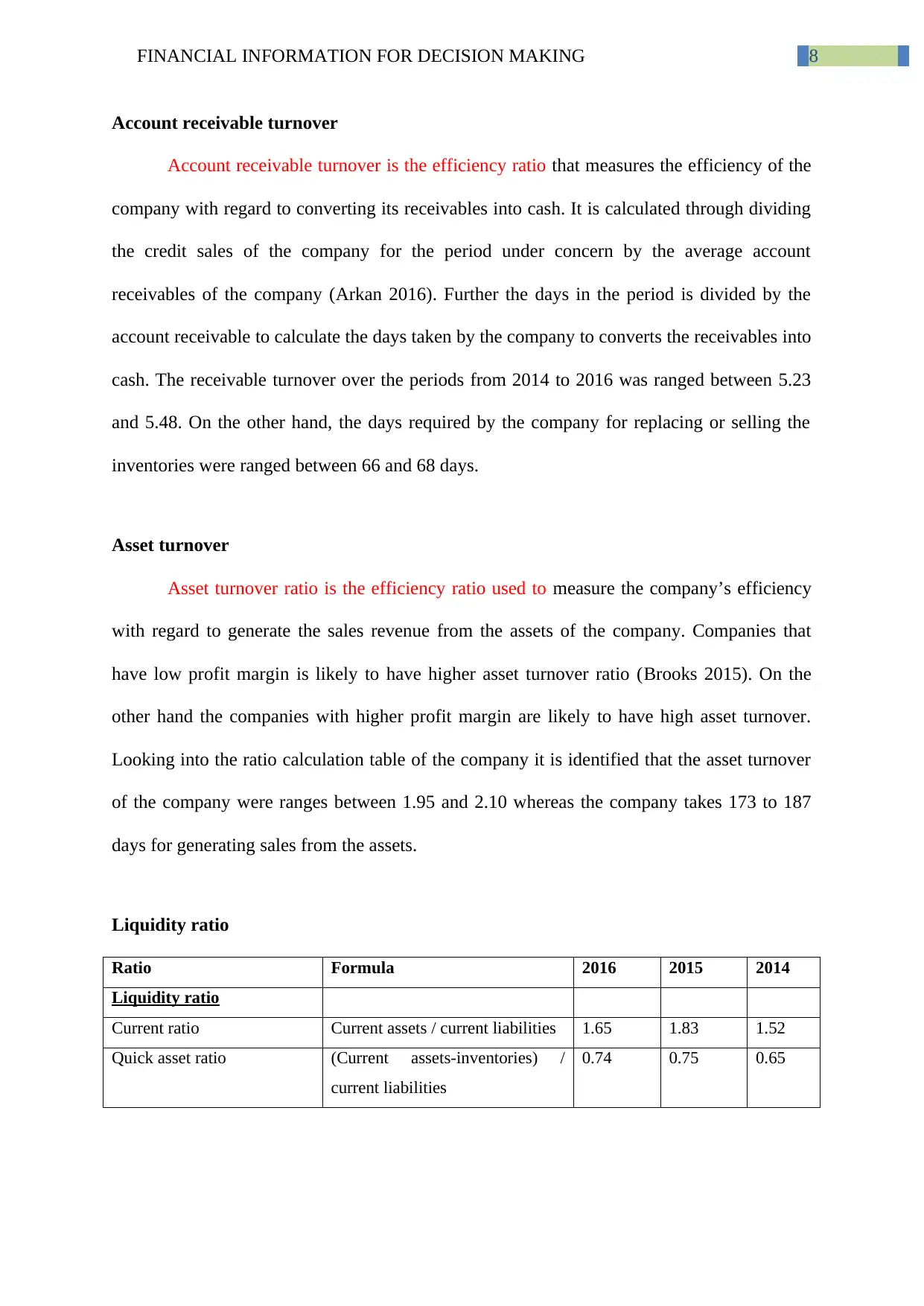
8FINANCIAL INFORMATION FOR DECISION MAKING
Account receivable turnover
Account receivable turnover is the efficiency ratio that measures the efficiency of the
company with regard to converting its receivables into cash. It is calculated through dividing
the credit sales of the company for the period under concern by the average account
receivables of the company (Arkan 2016). Further the days in the period is divided by the
account receivable to calculate the days taken by the company to converts the receivables into
cash. The receivable turnover over the periods from 2014 to 2016 was ranged between 5.23
and 5.48. On the other hand, the days required by the company for replacing or selling the
inventories were ranged between 66 and 68 days.
Asset turnover
Asset turnover ratio is the efficiency ratio used to measure the company’s efficiency
with regard to generate the sales revenue from the assets of the company. Companies that
have low profit margin is likely to have higher asset turnover ratio (Brooks 2015). On the
other hand the companies with higher profit margin are likely to have high asset turnover.
Looking into the ratio calculation table of the company it is identified that the asset turnover
of the company were ranges between 1.95 and 2.10 whereas the company takes 173 to 187
days for generating sales from the assets.
Liquidity ratio
Ratio Formula 2016 2015 2014
Liquidity ratio
Current ratio Current assets / current liabilities 1.65 1.83 1.52
Quick asset ratio (Current assets-inventories) /
current liabilities
0.74 0.75 0.65
Account receivable turnover
Account receivable turnover is the efficiency ratio that measures the efficiency of the
company with regard to converting its receivables into cash. It is calculated through dividing
the credit sales of the company for the period under concern by the average account
receivables of the company (Arkan 2016). Further the days in the period is divided by the
account receivable to calculate the days taken by the company to converts the receivables into
cash. The receivable turnover over the periods from 2014 to 2016 was ranged between 5.23
and 5.48. On the other hand, the days required by the company for replacing or selling the
inventories were ranged between 66 and 68 days.
Asset turnover
Asset turnover ratio is the efficiency ratio used to measure the company’s efficiency
with regard to generate the sales revenue from the assets of the company. Companies that
have low profit margin is likely to have higher asset turnover ratio (Brooks 2015). On the
other hand the companies with higher profit margin are likely to have high asset turnover.
Looking into the ratio calculation table of the company it is identified that the asset turnover
of the company were ranges between 1.95 and 2.10 whereas the company takes 173 to 187
days for generating sales from the assets.
Liquidity ratio
Ratio Formula 2016 2015 2014
Liquidity ratio
Current ratio Current assets / current liabilities 1.65 1.83 1.52
Quick asset ratio (Current assets-inventories) /
current liabilities
0.74 0.75 0.65
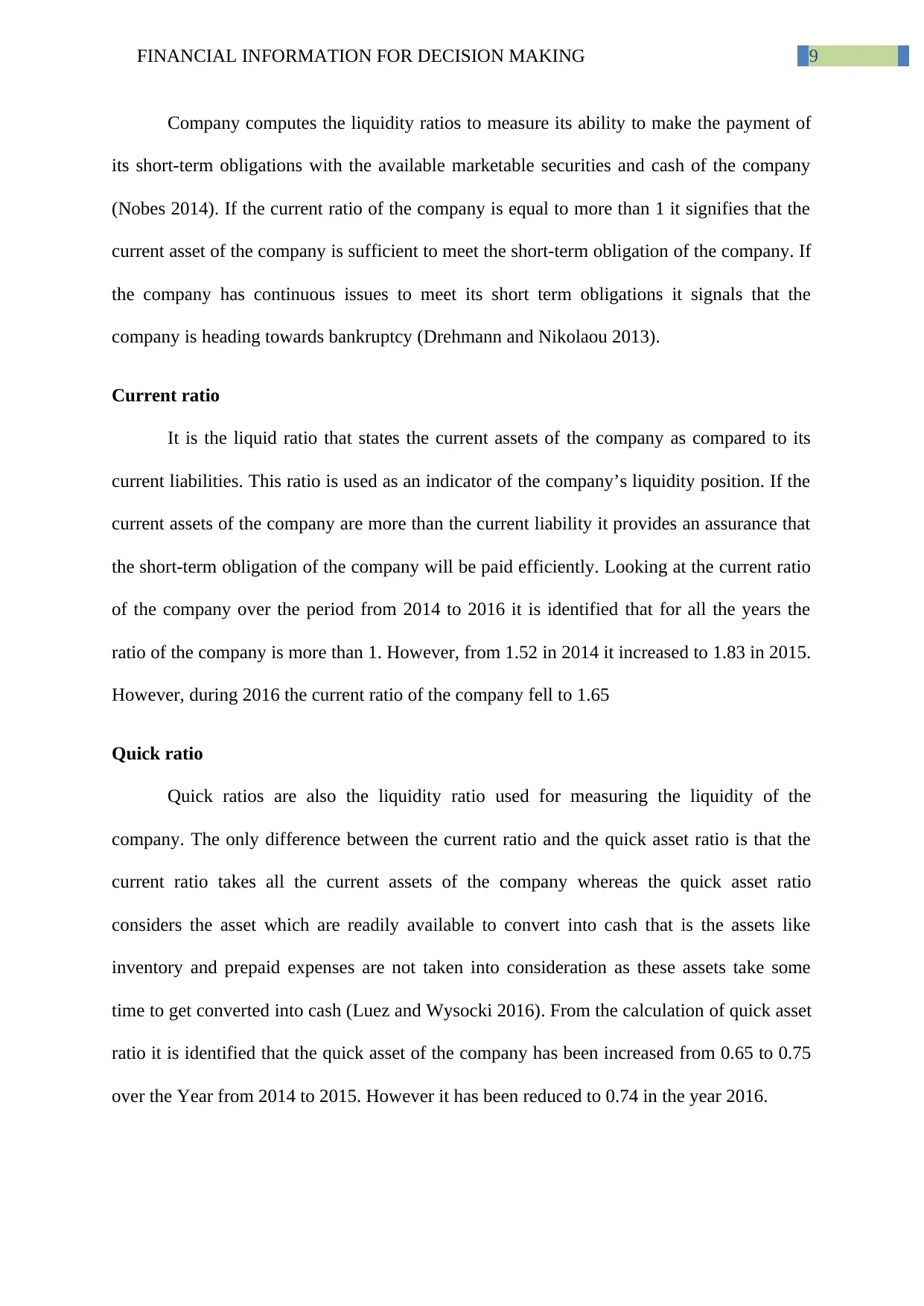
9FINANCIAL INFORMATION FOR DECISION MAKING
Company computes the liquidity ratios to measure its ability to make the payment of
its short-term obligations with the available marketable securities and cash of the company
(Nobes 2014). If the current ratio of the company is equal to more than 1 it signifies that the
current asset of the company is sufficient to meet the short-term obligation of the company. If
the company has continuous issues to meet its short term obligations it signals that the
company is heading towards bankruptcy (Drehmann and Nikolaou 2013).
Current ratio
It is the liquid ratio that states the current assets of the company as compared to its
current liabilities. This ratio is used as an indicator of the company’s liquidity position. If the
current assets of the company are more than the current liability it provides an assurance that
the short-term obligation of the company will be paid efficiently. Looking at the current ratio
of the company over the period from 2014 to 2016 it is identified that for all the years the
ratio of the company is more than 1. However, from 1.52 in 2014 it increased to 1.83 in 2015.
However, during 2016 the current ratio of the company fell to 1.65
Quick ratio
Quick ratios are also the liquidity ratio used for measuring the liquidity of the
company. The only difference between the current ratio and the quick asset ratio is that the
current ratio takes all the current assets of the company whereas the quick asset ratio
considers the asset which are readily available to convert into cash that is the assets like
inventory and prepaid expenses are not taken into consideration as these assets take some
time to get converted into cash (Luez and Wysocki 2016). From the calculation of quick asset
ratio it is identified that the quick asset of the company has been increased from 0.65 to 0.75
over the Year from 2014 to 2015. However it has been reduced to 0.74 in the year 2016.
Company computes the liquidity ratios to measure its ability to make the payment of
its short-term obligations with the available marketable securities and cash of the company
(Nobes 2014). If the current ratio of the company is equal to more than 1 it signifies that the
current asset of the company is sufficient to meet the short-term obligation of the company. If
the company has continuous issues to meet its short term obligations it signals that the
company is heading towards bankruptcy (Drehmann and Nikolaou 2013).
Current ratio
It is the liquid ratio that states the current assets of the company as compared to its
current liabilities. This ratio is used as an indicator of the company’s liquidity position. If the
current assets of the company are more than the current liability it provides an assurance that
the short-term obligation of the company will be paid efficiently. Looking at the current ratio
of the company over the period from 2014 to 2016 it is identified that for all the years the
ratio of the company is more than 1. However, from 1.52 in 2014 it increased to 1.83 in 2015.
However, during 2016 the current ratio of the company fell to 1.65
Quick ratio
Quick ratios are also the liquidity ratio used for measuring the liquidity of the
company. The only difference between the current ratio and the quick asset ratio is that the
current ratio takes all the current assets of the company whereas the quick asset ratio
considers the asset which are readily available to convert into cash that is the assets like
inventory and prepaid expenses are not taken into consideration as these assets take some
time to get converted into cash (Luez and Wysocki 2016). From the calculation of quick asset
ratio it is identified that the quick asset of the company has been increased from 0.65 to 0.75
over the Year from 2014 to 2015. However it has been reduced to 0.74 in the year 2016.
Secure Best Marks with AI Grader
Need help grading? Try our AI Grader for instant feedback on your assignments.
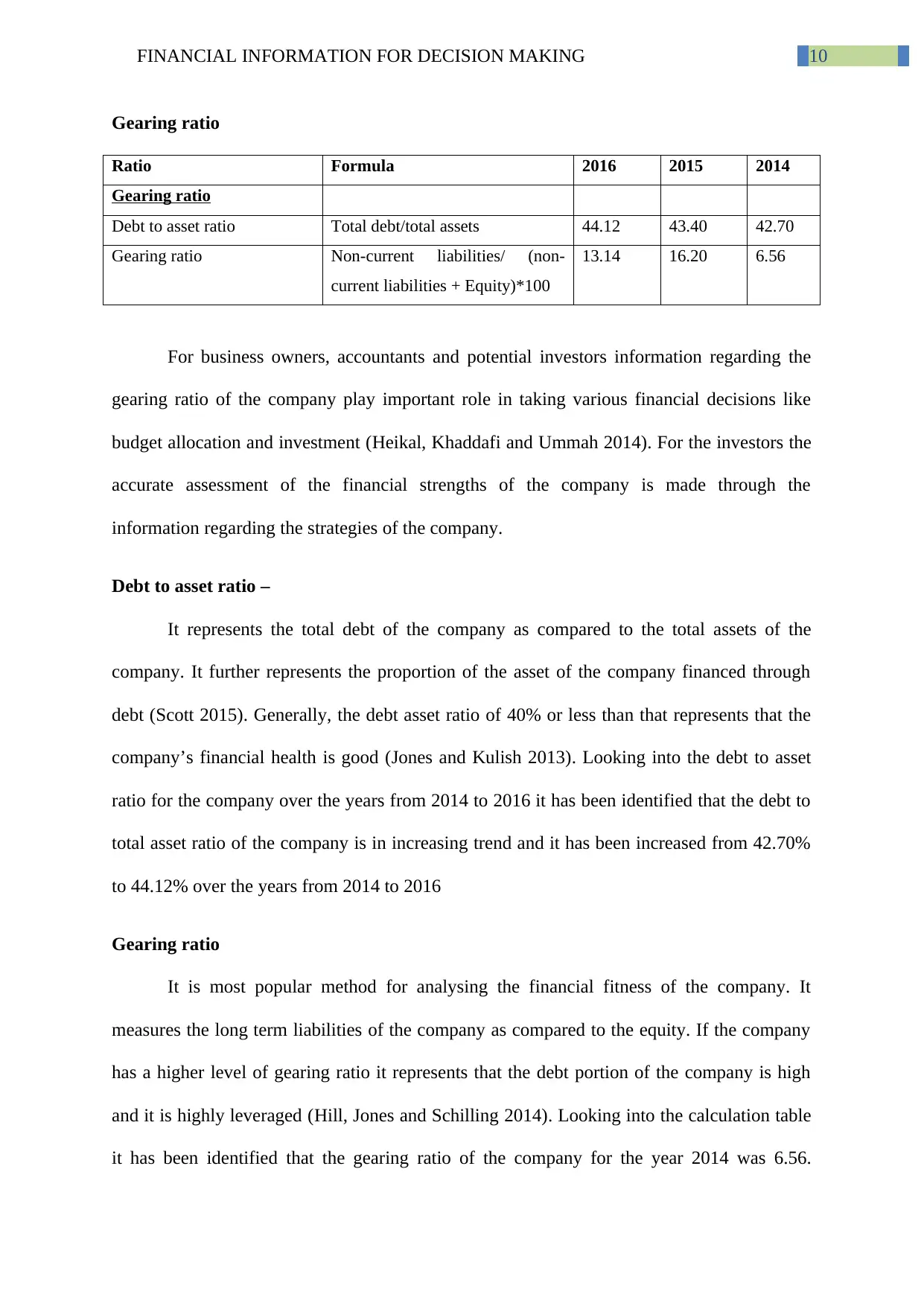
10FINANCIAL INFORMATION FOR DECISION MAKING
Gearing ratio
Ratio Formula 2016 2015 2014
Gearing ratio
Debt to asset ratio Total debt/total assets 44.12 43.40 42.70
Gearing ratio Non-current liabilities/ (non-
current liabilities + Equity)*100
13.14 16.20 6.56
For business owners, accountants and potential investors information regarding the
gearing ratio of the company play important role in taking various financial decisions like
budget allocation and investment (Heikal, Khaddafi and Ummah 2014). For the investors the
accurate assessment of the financial strengths of the company is made through the
information regarding the strategies of the company.
Debt to asset ratio –
It represents the total debt of the company as compared to the total assets of the
company. It further represents the proportion of the asset of the company financed through
debt (Scott 2015). Generally, the debt asset ratio of 40% or less than that represents that the
company’s financial health is good (Jones and Kulish 2013). Looking into the debt to asset
ratio for the company over the years from 2014 to 2016 it has been identified that the debt to
total asset ratio of the company is in increasing trend and it has been increased from 42.70%
to 44.12% over the years from 2014 to 2016
Gearing ratio
It is most popular method for analysing the financial fitness of the company. It
measures the long term liabilities of the company as compared to the equity. If the company
has a higher level of gearing ratio it represents that the debt portion of the company is high
and it is highly leveraged (Hill, Jones and Schilling 2014). Looking into the calculation table
it has been identified that the gearing ratio of the company for the year 2014 was 6.56.
Gearing ratio
Ratio Formula 2016 2015 2014
Gearing ratio
Debt to asset ratio Total debt/total assets 44.12 43.40 42.70
Gearing ratio Non-current liabilities/ (non-
current liabilities + Equity)*100
13.14 16.20 6.56
For business owners, accountants and potential investors information regarding the
gearing ratio of the company play important role in taking various financial decisions like
budget allocation and investment (Heikal, Khaddafi and Ummah 2014). For the investors the
accurate assessment of the financial strengths of the company is made through the
information regarding the strategies of the company.
Debt to asset ratio –
It represents the total debt of the company as compared to the total assets of the
company. It further represents the proportion of the asset of the company financed through
debt (Scott 2015). Generally, the debt asset ratio of 40% or less than that represents that the
company’s financial health is good (Jones and Kulish 2013). Looking into the debt to asset
ratio for the company over the years from 2014 to 2016 it has been identified that the debt to
total asset ratio of the company is in increasing trend and it has been increased from 42.70%
to 44.12% over the years from 2014 to 2016
Gearing ratio
It is most popular method for analysing the financial fitness of the company. It
measures the long term liabilities of the company as compared to the equity. If the company
has a higher level of gearing ratio it represents that the debt portion of the company is high
and it is highly leveraged (Hill, Jones and Schilling 2014). Looking into the calculation table
it has been identified that the gearing ratio of the company for the year 2014 was 6.56.
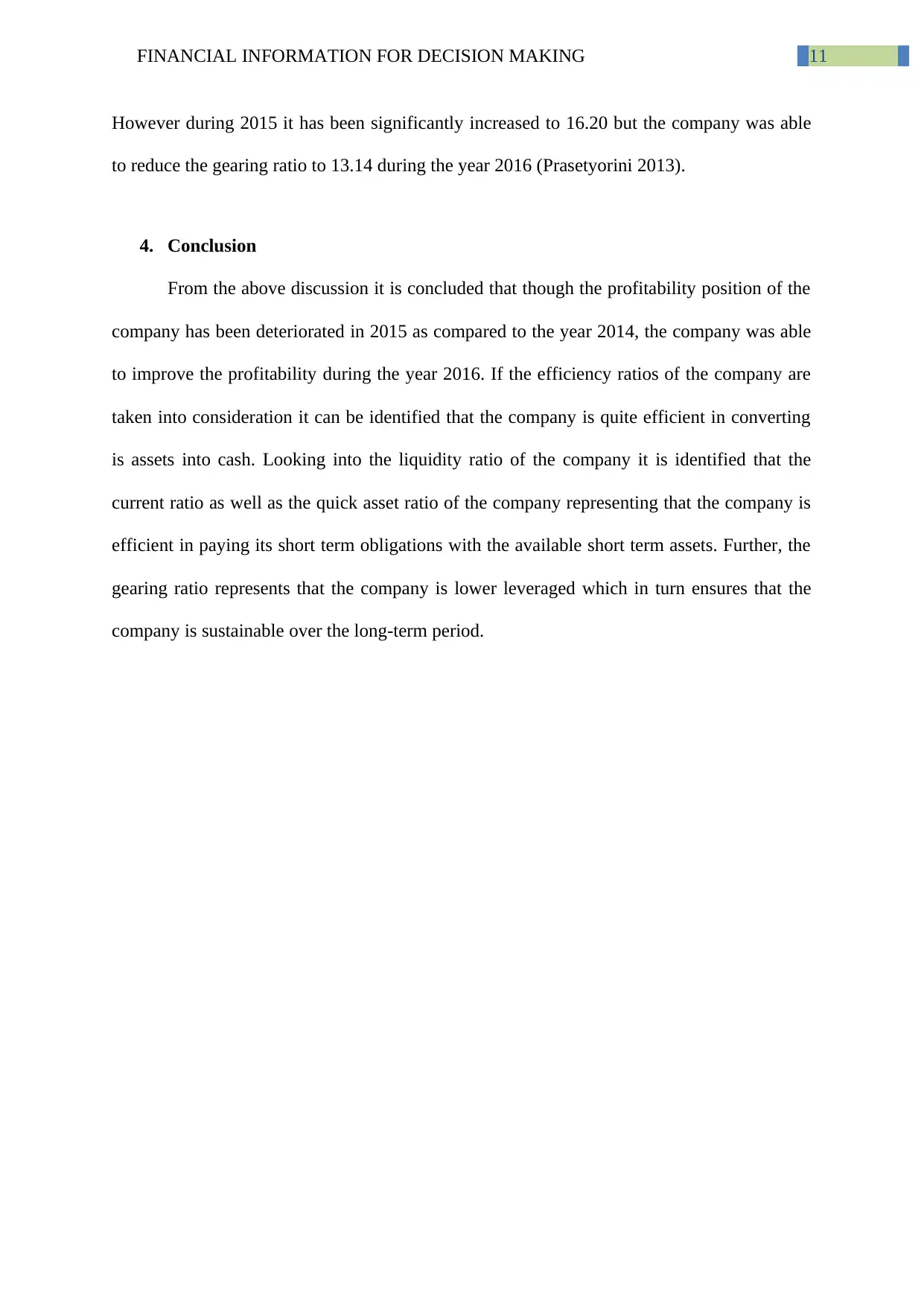
11FINANCIAL INFORMATION FOR DECISION MAKING
However during 2015 it has been significantly increased to 16.20 but the company was able
to reduce the gearing ratio to 13.14 during the year 2016 (Prasetyorini 2013).
4. Conclusion
From the above discussion it is concluded that though the profitability position of the
company has been deteriorated in 2015 as compared to the year 2014, the company was able
to improve the profitability during the year 2016. If the efficiency ratios of the company are
taken into consideration it can be identified that the company is quite efficient in converting
is assets into cash. Looking into the liquidity ratio of the company it is identified that the
current ratio as well as the quick asset ratio of the company representing that the company is
efficient in paying its short term obligations with the available short term assets. Further, the
gearing ratio represents that the company is lower leveraged which in turn ensures that the
company is sustainable over the long-term period.
However during 2015 it has been significantly increased to 16.20 but the company was able
to reduce the gearing ratio to 13.14 during the year 2016 (Prasetyorini 2013).
4. Conclusion
From the above discussion it is concluded that though the profitability position of the
company has been deteriorated in 2015 as compared to the year 2014, the company was able
to improve the profitability during the year 2016. If the efficiency ratios of the company are
taken into consideration it can be identified that the company is quite efficient in converting
is assets into cash. Looking into the liquidity ratio of the company it is identified that the
current ratio as well as the quick asset ratio of the company representing that the company is
efficient in paying its short term obligations with the available short term assets. Further, the
gearing ratio represents that the company is lower leveraged which in turn ensures that the
company is sustainable over the long-term period.
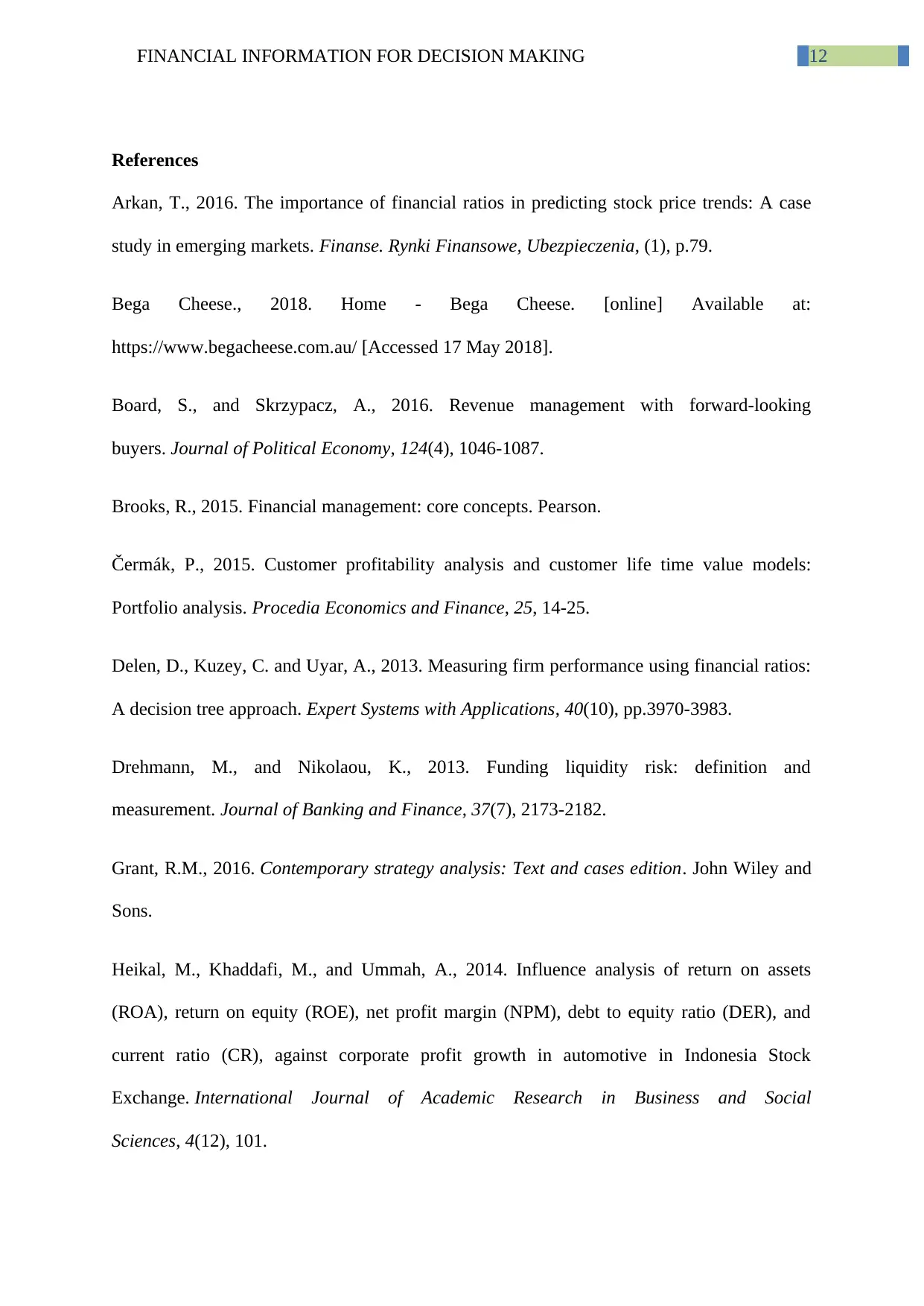
12FINANCIAL INFORMATION FOR DECISION MAKING
References
Arkan, T., 2016. The importance of financial ratios in predicting stock price trends: A case
study in emerging markets. Finanse. Rynki Finansowe, Ubezpieczenia, (1), p.79.
Bega Cheese., 2018. Home - Bega Cheese. [online] Available at:
https://www.begacheese.com.au/ [Accessed 17 May 2018].
Board, S., and Skrzypacz, A., 2016. Revenue management with forward-looking
buyers. Journal of Political Economy, 124(4), 1046-1087.
Brooks, R., 2015. Financial management: core concepts. Pearson.
Čermák, P., 2015. Customer profitability analysis and customer life time value models:
Portfolio analysis. Procedia Economics and Finance, 25, 14-25.
Delen, D., Kuzey, C. and Uyar, A., 2013. Measuring firm performance using financial ratios:
A decision tree approach. Expert Systems with Applications, 40(10), pp.3970-3983.
Drehmann, M., and Nikolaou, K., 2013. Funding liquidity risk: definition and
measurement. Journal of Banking and Finance, 37(7), 2173-2182.
Grant, R.M., 2016. Contemporary strategy analysis: Text and cases edition. John Wiley and
Sons.
Heikal, M., Khaddafi, M., and Ummah, A., 2014. Influence analysis of return on assets
(ROA), return on equity (ROE), net profit margin (NPM), debt to equity ratio (DER), and
current ratio (CR), against corporate profit growth in automotive in Indonesia Stock
Exchange. International Journal of Academic Research in Business and Social
Sciences, 4(12), 101.
References
Arkan, T., 2016. The importance of financial ratios in predicting stock price trends: A case
study in emerging markets. Finanse. Rynki Finansowe, Ubezpieczenia, (1), p.79.
Bega Cheese., 2018. Home - Bega Cheese. [online] Available at:
https://www.begacheese.com.au/ [Accessed 17 May 2018].
Board, S., and Skrzypacz, A., 2016. Revenue management with forward-looking
buyers. Journal of Political Economy, 124(4), 1046-1087.
Brooks, R., 2015. Financial management: core concepts. Pearson.
Čermák, P., 2015. Customer profitability analysis and customer life time value models:
Portfolio analysis. Procedia Economics and Finance, 25, 14-25.
Delen, D., Kuzey, C. and Uyar, A., 2013. Measuring firm performance using financial ratios:
A decision tree approach. Expert Systems with Applications, 40(10), pp.3970-3983.
Drehmann, M., and Nikolaou, K., 2013. Funding liquidity risk: definition and
measurement. Journal of Banking and Finance, 37(7), 2173-2182.
Grant, R.M., 2016. Contemporary strategy analysis: Text and cases edition. John Wiley and
Sons.
Heikal, M., Khaddafi, M., and Ummah, A., 2014. Influence analysis of return on assets
(ROA), return on equity (ROE), net profit margin (NPM), debt to equity ratio (DER), and
current ratio (CR), against corporate profit growth in automotive in Indonesia Stock
Exchange. International Journal of Academic Research in Business and Social
Sciences, 4(12), 101.
Paraphrase This Document
Need a fresh take? Get an instant paraphrase of this document with our AI Paraphraser
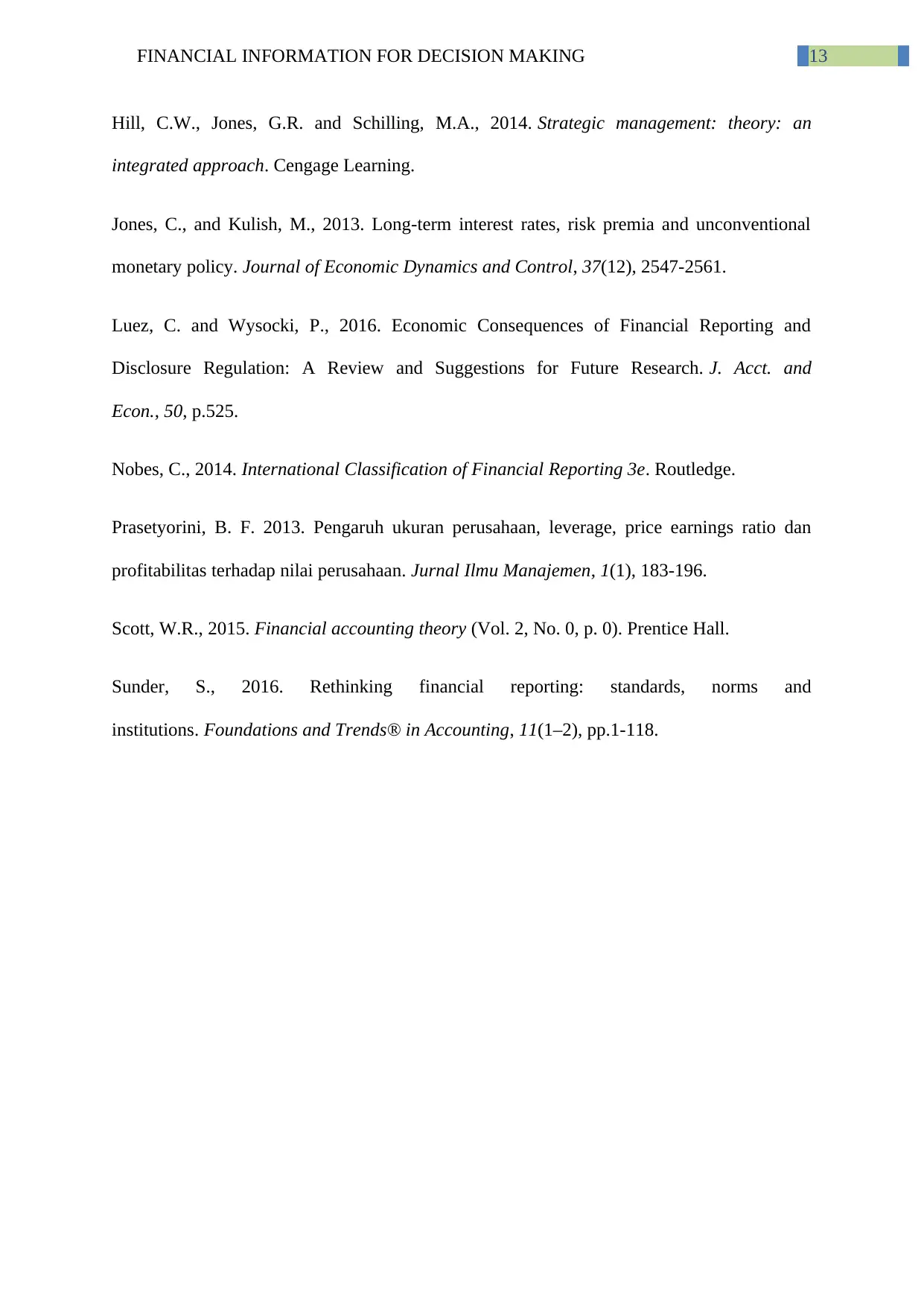
13FINANCIAL INFORMATION FOR DECISION MAKING
Hill, C.W., Jones, G.R. and Schilling, M.A., 2014. Strategic management: theory: an
integrated approach. Cengage Learning.
Jones, C., and Kulish, M., 2013. Long-term interest rates, risk premia and unconventional
monetary policy. Journal of Economic Dynamics and Control, 37(12), 2547-2561.
Luez, C. and Wysocki, P., 2016. Economic Consequences of Financial Reporting and
Disclosure Regulation: A Review and Suggestions for Future Research. J. Acct. and
Econ., 50, p.525.
Nobes, C., 2014. International Classification of Financial Reporting 3e. Routledge.
Prasetyorini, B. F. 2013. Pengaruh ukuran perusahaan, leverage, price earnings ratio dan
profitabilitas terhadap nilai perusahaan. Jurnal Ilmu Manajemen, 1(1), 183-196.
Scott, W.R., 2015. Financial accounting theory (Vol. 2, No. 0, p. 0). Prentice Hall.
Sunder, S., 2016. Rethinking financial reporting: standards, norms and
institutions. Foundations and Trends® in Accounting, 11(1–2), pp.1-118.
Hill, C.W., Jones, G.R. and Schilling, M.A., 2014. Strategic management: theory: an
integrated approach. Cengage Learning.
Jones, C., and Kulish, M., 2013. Long-term interest rates, risk premia and unconventional
monetary policy. Journal of Economic Dynamics and Control, 37(12), 2547-2561.
Luez, C. and Wysocki, P., 2016. Economic Consequences of Financial Reporting and
Disclosure Regulation: A Review and Suggestions for Future Research. J. Acct. and
Econ., 50, p.525.
Nobes, C., 2014. International Classification of Financial Reporting 3e. Routledge.
Prasetyorini, B. F. 2013. Pengaruh ukuran perusahaan, leverage, price earnings ratio dan
profitabilitas terhadap nilai perusahaan. Jurnal Ilmu Manajemen, 1(1), 183-196.
Scott, W.R., 2015. Financial accounting theory (Vol. 2, No. 0, p. 0). Prentice Hall.
Sunder, S., 2016. Rethinking financial reporting: standards, norms and
institutions. Foundations and Trends® in Accounting, 11(1–2), pp.1-118.

14FINANCIAL INFORMATION FOR DECISION MAKING
Appendix
Ratio Formula 2016 2015 2014
Profitability
ratio
Return on
shareholder's
equity
Net income / Average
shareholder's equity
=28779/
((327838+3126
66)/2)*100
=12408/
((312666+3143
88)/2)*100
=66055/
((314388+261
952)/2)*100
Return on total
asset
Net income / Average total
assets
=28779/
((586674+5524
19)/2)*100
=12408/
((552419+5486
37)/2)*100
=66055/
((548637+549
221)/2)*100
Net profit margin Net profit / Sales *100 =28779/11959
67*100
=12408/11126
30*100
=66055/10693
92*100
Efficiency ratio
Inventory
turnover
Cost of goods sold/
average inventory
=1042595/
((192398+1948
89)/2)
=991538/
((194889+1841
67)/2)
=951117/
((184167+163
027)/2)
Inventory
turnover in days
365/inventory turnover =365/5.38 =365/5.23 =365/5.48
Settlement period
for account
receivable
Credit sales/ average
receivables
=1195967/
((143673+1195
08)/2)
=1112630/
((119508+1066
60)/2)
=1069392/
((106660+103
476)/2)
Account
receivable in days
365/Account receivable
ratio
=365/9.09 =365/9.84 =365/10.18
Appendix
Ratio Formula 2016 2015 2014
Profitability
ratio
Return on
shareholder's
equity
Net income / Average
shareholder's equity
=28779/
((327838+3126
66)/2)*100
=12408/
((312666+3143
88)/2)*100
=66055/
((314388+261
952)/2)*100
Return on total
asset
Net income / Average total
assets
=28779/
((586674+5524
19)/2)*100
=12408/
((552419+5486
37)/2)*100
=66055/
((548637+549
221)/2)*100
Net profit margin Net profit / Sales *100 =28779/11959
67*100
=12408/11126
30*100
=66055/10693
92*100
Efficiency ratio
Inventory
turnover
Cost of goods sold/
average inventory
=1042595/
((192398+1948
89)/2)
=991538/
((194889+1841
67)/2)
=951117/
((184167+163
027)/2)
Inventory
turnover in days
365/inventory turnover =365/5.38 =365/5.23 =365/5.48
Settlement period
for account
receivable
Credit sales/ average
receivables
=1195967/
((143673+1195
08)/2)
=1112630/
((119508+1066
60)/2)
=1069392/
((106660+103
476)/2)
Account
receivable in days
365/Account receivable
ratio
=365/9.09 =365/9.84 =365/10.18
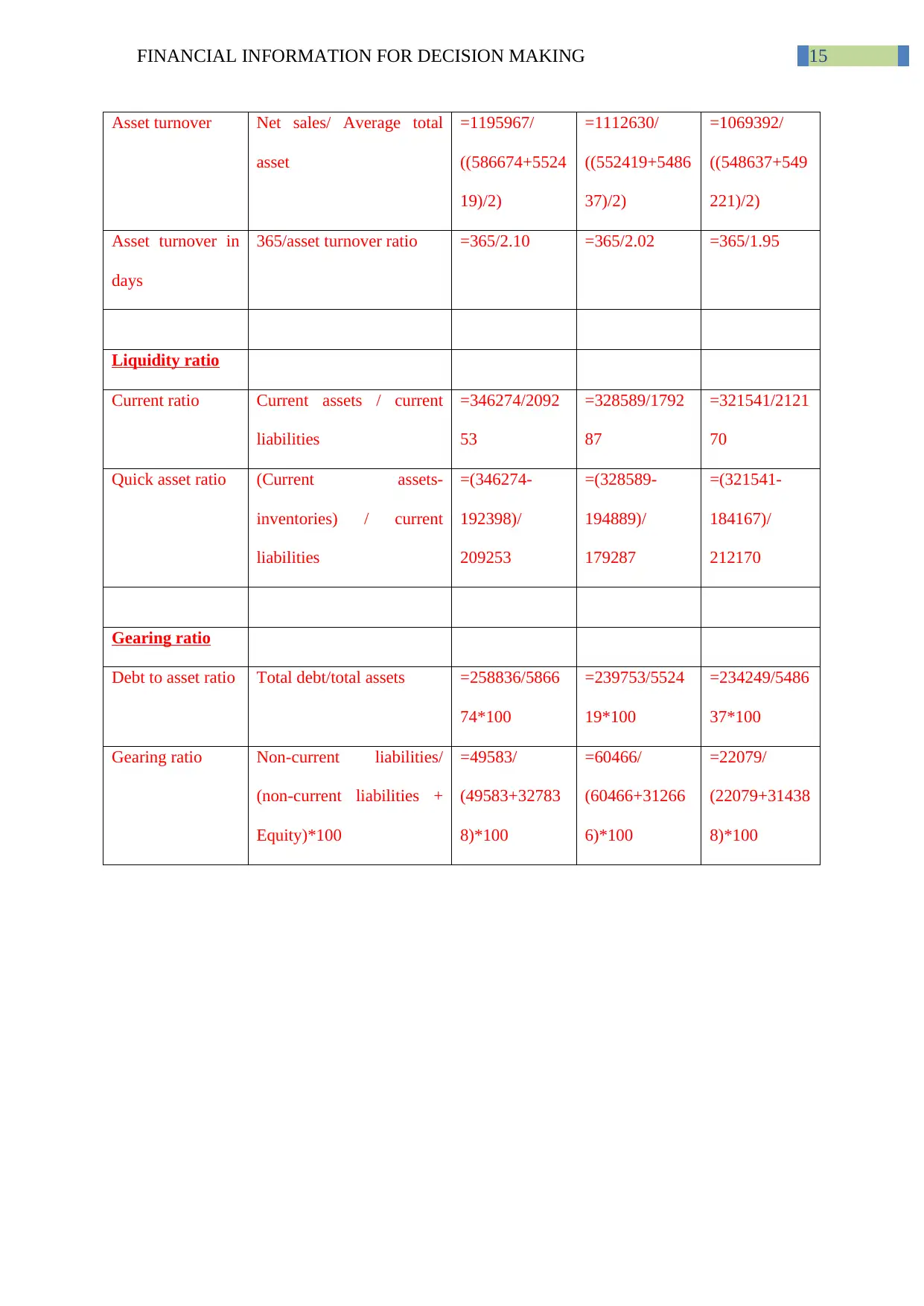
15FINANCIAL INFORMATION FOR DECISION MAKING
Asset turnover Net sales/ Average total
asset
=1195967/
((586674+5524
19)/2)
=1112630/
((552419+5486
37)/2)
=1069392/
((548637+549
221)/2)
Asset turnover in
days
365/asset turnover ratio =365/2.10 =365/2.02 =365/1.95
Liquidity ratio
Current ratio Current assets / current
liabilities
=346274/2092
53
=328589/1792
87
=321541/2121
70
Quick asset ratio (Current assets-
inventories) / current
liabilities
=(346274-
192398)/
209253
=(328589-
194889)/
179287
=(321541-
184167)/
212170
Gearing ratio
Debt to asset ratio Total debt/total assets =258836/5866
74*100
=239753/5524
19*100
=234249/5486
37*100
Gearing ratio Non-current liabilities/
(non-current liabilities +
Equity)*100
=49583/
(49583+32783
8)*100
=60466/
(60466+31266
6)*100
=22079/
(22079+31438
8)*100
Asset turnover Net sales/ Average total
asset
=1195967/
((586674+5524
19)/2)
=1112630/
((552419+5486
37)/2)
=1069392/
((548637+549
221)/2)
Asset turnover in
days
365/asset turnover ratio =365/2.10 =365/2.02 =365/1.95
Liquidity ratio
Current ratio Current assets / current
liabilities
=346274/2092
53
=328589/1792
87
=321541/2121
70
Quick asset ratio (Current assets-
inventories) / current
liabilities
=(346274-
192398)/
209253
=(328589-
194889)/
179287
=(321541-
184167)/
212170
Gearing ratio
Debt to asset ratio Total debt/total assets =258836/5866
74*100
=239753/5524
19*100
=234249/5486
37*100
Gearing ratio Non-current liabilities/
(non-current liabilities +
Equity)*100
=49583/
(49583+32783
8)*100
=60466/
(60466+31266
6)*100
=22079/
(22079+31438
8)*100
1 out of 16
Related Documents
Your All-in-One AI-Powered Toolkit for Academic Success.
+13062052269
info@desklib.com
Available 24*7 on WhatsApp / Email
![[object Object]](/_next/static/media/star-bottom.7253800d.svg)
Unlock your academic potential
© 2024 | Zucol Services PVT LTD | All rights reserved.




